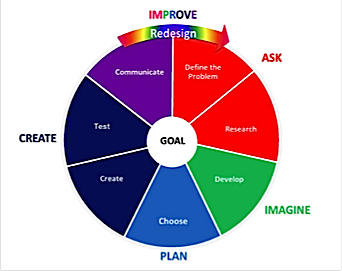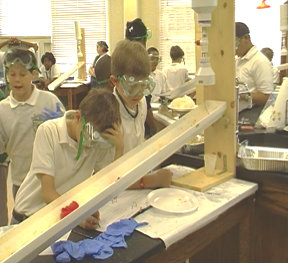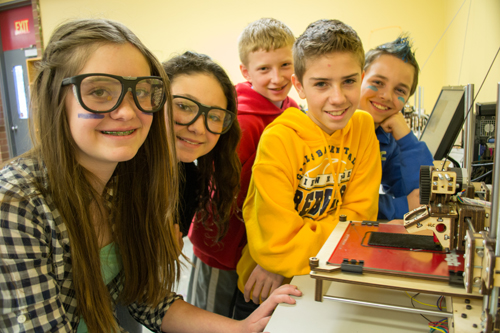A Welcome Letter to New STEM Students
A MiddleWeb Blog
If I could choose any time to live, I would want to be a teenager now (in a country where great education is available). The reason I would choose to be a young person today, rather than during some earlier period in history, is that now, more than at any other time, young people will make a spectacular difference.” — James Martin, The 17 Great Challenges of the Twenty-First Century
What do you know about the world you are going to enter when you finish school? What challenges and problems will we face? What jobs will be out there? What skills and learning will graduates need?
We don’t actually know all the answers to those questions, but one thing we do know: businesses and industry are already experiencing shortages in STEM workers – the workers who know how to tackle the tough problems facing the 21st Century. We need folks who can solve problems in areas such as energy, clean water, health and medicine, environmental issues, extreme poverty, and technology risks (to mention a few).
To prepare you for this world, we are going to be teaching some STEM lessons in our science and math classes. Here is what that’s going to look like.
You will be working in teams to solve a real problem.
Take a look around and make some suggestions for problems you might take a stab at solving. You may have noticed that runoff from your school campus is carrying soil into the local watershed. You may have seen materials that could be recycled and used to construct something useful. Maybe the band needs some sort of musical device to produce a specific sound for a program.
Or perhaps you could design a safer infant seat; a faster roller coaster, a locker caddy, a device to deliver a newspaper to a doorstep from a car, disposable lunchroom trays, a way to speed up photosynthesis in plants, or a solar-powered device. You might even try designing a container to transport plants to a biosphere on Mars. These are all ideas that have been pursued by STEM students like you. The possibilities are endless.

Once you know the problem, your team will do some research to get information about that problem. That doesn’t mean you’ll have your heads buried in books – although that might be part of it.
You might interview some experts or conduct experiments to get information. You might find kids in other schools who have worked on this same problem and talk to them via Skype. You might locate some online games or apps that help you understand what science and math to consider as you approach this problem.
Basically, team members will gather information to help them make decisions that might work to solve the problem.
Based on what you learn, you and your teammates will brainstorm and develop ideas for how to solve the problem and then choose the idea you think might work best. The neat thing is that you don’t have to worry about coming up with “the” right answer. There can be several correct solutions. Your team might come up with an entirely different solution than any other team. That’s great!
Solutions generally involve creating a model, or a prototype. After constructing your prototype you will test it and evaluate the results to see if it works to solve the problem.

Mobile, AL students test their streambed barriers.
Uh oh! What if it doesn’t work? What if your prototype fails?
As a matter of fact, engineers will tell you that prototype failure happens most of the time when constructing devices to solve problems. The first idea out of the chute seldom works. So, no worries! Failure is part of the learning cycle, and you’ll use what you learn from the first try to help you redesign a better solution.
Speaking of redesign, you’ll usually figure out ways to redesign your device even if it does work, so that it works better. Communication is an important part of STEM, so you’ll need to figure out as a team how to best communicate your results. It might be through technical writing, drama, or graphic arts.
STEM lessons are hands-on and will involve everyone in working together to produce solutions for problems.
What will STEM lessons require of you?
Remember that you will be working in teams. Have you ever worked in a team that didn’t get much done because someone dominated, and someone else didn’t participate at all? That mustn’t happen in a STEM team. You’ll be operating like a group of student engineers, and you should operate in a smooth, cooperative way. You want your team to be the very best in the class. So will you make sure of that? Your teacher will lead you through some basics of good teamwork, but I’ll mention a few right here.
Set some guidelines for your team. Base these guidelines on behaviors you all like to see in other team members. Do you like for all team members to share the work that needs to be done? Do you like for them to take turns talking? Do you like for everyone to take the work seriously and do their best? Then you should write those kinds of behaviors in your team guidelines.
Show respect for others, listen carefully to their ideas, and make everyone feel valued. This isn’t the time to be bossy or show off. And it’s not the time to sit back and let others run the show. This is the time to learn to work together to tackle a problem.
Be as creative as you like. Remember, there’s not just one right answer. Don’t be afraid to suggest some far-out ideas and be innovative. Come up with unique solutions if you like.
Be ready to use both science and math in your solutions. If you don’t understand the science or math involved, be sure to ask for clarification. A teammate might be able to explain, and your teacher will be available to help as well. As you use both science and math to solve problems, notice that these aren’t really the different subjects they seem to be when taught in separate classes. Learning to apply them will help you understand them better.
Use and create technology. You will probably use several types of technology: digital technology, science equipment, and other lesson materials. Actually, when you create a device to solve a problem, you are creating a technology. That’s what technology is – anything made by people to meet a need or a want.
Have a lot of fun with these STEM projects, and take them seriously. They will teach you how to approach problems, and research and design solutions for the issues that will face our society by the time you graduate. STEM will help you make sense of science and math because you will apply these in solving problems and meeting challenges. Even if you don’t go into a STEM field, you will be better prepared for life because of what you will learn through STEM coursework.
Have fun learning!
Want to share this letter with your students? Here it is in PDF format. Please feel free to copy or adapt it. Prefer a Word format?




































Great post, Ann! I’m going to share it with my group.
Thanks so much, David! If your teachers need to make adjustments based on what they plan to do, I can send it to you as Word Doc.
Hi Ann! Your posts are so inspiring! Do you have any resources for best practices in designing the physical space of a STEM Lab (particularly K-8)?
I wish I could help you with the physical space question, Linsey. I had a large science lab room with a modern layout and plenty of space for kids to move. And I had plenty of storage space for equipment and a way to keep some of it locked up as needed. If you go to this link http://bit.ly/1FTV6HU you will see pictures of many types of layouts for science labs. I would think that STEM labs would need tables for each team.
Glad you enjoyed the post!
Anne
Thank you, this letter is just what I needed to share with my teachers as well as our scholars. We are moving toward being a STEM school next year.
That’s great! Good luck in becoming a STEM school – it takes thoughtful preparation, a concrete knowledge of what you want the school to “be” and accomplish for students, and hopefully some community and parent support. Right on!
I am very impressed with how you organized your presentation. This is one of the better descriptions of how STEM looks and works in schools. Kudos to you and your professionalism.
Thanks so much Steven – I appreciate your comments and your encouragement.
Great article! We are going share a link to this on our FB page:https://www.facebook.com/GetCaughtEngineering
Thanks, Wendy! I’m glad that you find the article useful.